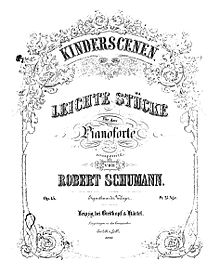The Symphonic Etudes (French: Études Symphoniques), Op. 13, is a set of études for solo piano by Robert Schumann. It began in 1834 as a theme and sixteen variations on a theme by Baron von Fricken, plus a further variation on an entirely different theme by Heinrich Marschner.
Composition
The first edition in 1837 carried an annotation that the tune was “the composition of an amateur”: this referred to the origin of the theme, which had been sent to Schumann by Baron von Fricken, guardian of Ernestine von Fricken, the Estrella of his Carnaval Op. 9. The baron, an amateur musician, had used the melody in a Theme with Variations for flute. Schumann had been engaged to Ernestine in 1834, only to break abruptly with her the year after. An autobiographical element is thus interwoven in the genesis of the Études symphoniques (as in that of many other works of Schumann’s).[1]
Of the sixteen variations Schumann composed on Fricken’s theme, only eleven were published by him. (An early version, completed between 1834 and January 1835, contained twelve movements). The final, twelfth, published étude was a variation on the theme from the Romance Du stolzes England freue dich (Proud England, rejoice!), from Heinrich Marschner‘s opera Der Templer und die Jüdin, which was based on Sir Walter Scott‘s Ivanhoe (as a tribute to Schumann’s English friend, William Sterndale Bennett). The earlier Fricken theme occasionally appears briefly during this étude. The work was first published in 1837 as XII Études Symphoniques. Only nine of the twelve études were specifically designated as variations. The sequence was as follows:
- Theme – Andante
- Etude I (Variation 1) – Un poco più vivo
- Etude II (Variation 2) – Andante
- Etude III – Vivace
- Etude IV (Variation 3) – Allegro marcato
- Etude V (Variation 4) – Scherzando
- Etude VI (Variation 5) – Agitato
- Etude VII (Variation 6) – Allegro molto
- Etude VIII (Variation 7) – Sempre marcatissimo
- Etude IX – Presto possibile
- Etude X (Variation 8) – Allegro con energia
- Etude XI (Variation 9) – Andante espressivo
- Etude XII (Finale) – Allegro brillante (based on Marschner’s theme).
Other titles had been considered in September 1834: Variations pathétiques and Etuden im Orchestercharakter von Florestan und Eusebius. In this latter case the Études would have been signed by two imaginary figures in whom Schumann personified two essential, opposite and complementary aspects of his own personality and his own poetic world. ‘Florestan and Eusebius’ then signed the Davidsbündlertänze, Op. 6; but only in the 1835 version of the Études symphoniques were the pieces divided so as to emphasize the alternation of more lyrical, melancholy and introvert pages (Eusebius) with those of a more excitable and dynamic nature (Florestan). In the 1837 version Florestan prevails.
Fifteen years later, in a second edition (Leipzig 1852), the 1837 title Études symphoniques became Études en forme de variations, two etudes (Nos. 3 and 9) that did not correspond to the new title (not being exactly variations) were eliminated, and some revisions were made in the piano writing.
The entire work was dedicated to Schumann’s English friend, the pianist and composer William Sterndale Bennett. Bennett played the piece frequently in England to great acclaim, but Schumann thought it was unsuitable for public performance and advised his wife Clara not to play it.
Later publication history
In 1861, five years after Schumann’s death, his father-in-law Friedrich Wieck published a third edition under the editorial pseudonym “DAS” (an acronym for Der alte Schulmeister). This edition attempted to reconcile the differences between the earlier two, and bore both the previous titles XII Études Symphoniques and Études en forme de variations.
On republishing the set in 1890, Johannes Brahms restored the five variations that had been cut by Schumann. These are now often played, but in positions within the cycle that vary somewhat with each performance; there are now twelve variations and these five so-called “posthumous” variations which exist as a supplement.
The five posthumously published sections (all based on Fricken’s theme) are:
- Variation I – Andante, Tempo del tema
- Variation II – Meno mosso
- Variation III – Allegro
- Variation IV – Allegretto
- Variation V – Moderato.
Orchestrations
Two sections, including the Allegro brillante, were orchestrated by Tchaikovsky, and have been recorded.[3]


















































































































































You must be logged in to post a comment.